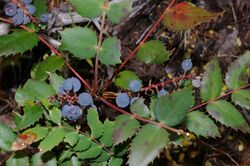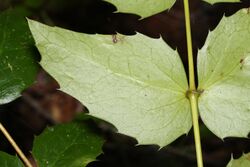Mahonia nervosa
Topic: Biology
 From HandWiki - Reading time: 4 min
From HandWiki - Reading time: 4 min
| Dull Oregon-grape | |
|---|---|

| |
| Scientific classification | |
| Kingdom: | Plantae |
| Clade: | Tracheophytes |
| Clade: | Angiosperms |
| Clade: | Eudicots |
| Order: | Ranunculales |
| Family: | Berberidaceae |
| Genus: | Mahonia |
| Species: | M. nervosa
|
| Binomial name | |
| Mahonia nervosa | |
| Synonyms[3] | |
Mahonia nervosa, commonly known as dwarf Oregon-grape, Cascade barberry, Cascade Oregon-grape, or dull Oregon-grape, is a flowering plant native to the northwest coast of North America from southern British Columbia south to central California , with an isolated population inland in northern Idaho.[4][5][6] It is especially common in second growth, Douglas-fir[7] or western redcedar forests, making use of those pools of sunlight that intermittently reach the ground.
Some authors place the entire genus Mahonia within the genus Berberis.[8][9][10]
The plant was collected by Lewis and Clark during their famous expedition to the West before being described for western science by Frederick T. Pursh in 1813.[11][12][13]
Description
It is an evergreen shrub with short vertical stems, mostly less than 24 in (61 cm), while the leaves reach higher, rarely up to 7 ft (2.1 m) tall on exceptional sites.
The leaves are compound and of opposite arrangement, with 9–19 leaflets; each leaflet is strongly toothed, reminiscent of holly, and somewhat shiny, but less so than tall Oregon-grape. The leaflets do not have a single central vein as in that species, but several veins arranged fan-like, branched from the leaflet base, hence the epithet nervosa.
The flowers bloom from early to late spring and are similar to those of other Oregon-grapes, forming small yellow flowers in erect clusters up to 8 inches (20 cm) in length.[14]
Like other species in the genus Mahonia, the fruit are dark-blue, globose berries of .3 inches (7.6 mm) in diameter which occur in clusters[14] and are tart-tasting.[13]
Ecology
Low Oregon-grape thrives in sun or shade and is a common or dominant species throughout the understories in montane, sub-montane, and mixed evergreen forests in the Pacific Northwest. It reaches greatest abundance on relatively dry and warm sites, but occurs in fairly moist environments as well. It grows in a variety of soil types. It is restricted to lower elevations, from sea level to 6,000 feet (1,800 m).[14]
Mahonia nervosa can complete its life cycle even in the deep shade of dense hemlock-western redcedar forests, so it is a climax species in old-growth forests where it is often dominant. It also occurs in disturbed sites, usually reaching peak abundance from 4 to 10 years after fire or clearcutting.[14]
The plant can reproduce via seeds or by vegetative means, sprouting from rhizomes which extend laterally through the soil.[14]
Its foliage is browsed by black-tailed deer and Roosevelt elk in some areas, but is ignored in others. Various small mammals feed on the foliage extensively, and it is extremely important food source for the white-footed vole in the Coast Range of Oregon. The fruits are eaten by small birds and mammals, and by black-tailed deer in some areas. The nectar of the genus Mahonia is favored by the Anna's hummingbird.[14]
Uses
Some Plateau Indian tribes drank an infusion of the root to treat rheumatism.[15] Modern medicine uses it against parasites, bacteria, viruses, diabetes, and high cholesterol.[13]
The Yana people dried and ground the fruits to make a mush. They can also be dried and eaten like raisins, or used for jelly.[13][16]
The inner bark is colored yellow by the alkaloid berberine, and was used as a dye by native groups.[13]
The leaves are often used in floral arrangements.[13]
References
- ↑ Roof, James B. Four Seasons 3(1): 8–10, f. s.n. [p. 9, upper right]. 1969.
- ↑ Roof, James B. Changing Seasons 1(3, Suppl.): 14. 1981.
- ↑ Tropicos
- ↑ Hickman, J. C. 1993. The Jepson Manual: Higher Plants of California 1–1400. University of California Press, Berkeley.
- ↑ Munz, P. A. & D. D. Keck. 1959. California Flora 1–1681. University of California Press, Berkeley.
- ↑ Hitchcock, C. H., A.J. Cronquist, F. M. Ownbey & J. W. Thompson. 1984. Salicaceae to Saxifragaceae. Part II: 1–597. In C. L. Hitchcock et al. Vascular Plants of the Pacific Northwest. University of Washington Press, Seattle.
- ↑ Pojar, Jim; MacKinnon, Andy, eds (1994). Plants of Coastal British Columbia: including Washington, Oregon & Alaska, rev. ed.. Vancouver: Lone Pine Publishing. p. 95. ISBN 978-1-55105-532-9.
- ↑ Loconte, H., & J. R. Estes. 1989. Phylogenetic systematics of Berberidaceae and Ranunculales (Magnoliidae). Systematic Botany 14:565–579.
- ↑ Marroquín, Jorge S., & Joseph E. Laferrière. 1997. Transfer of specific and infraspecific taxa from Mahonia to Berberis. Journal of the Arizona-Nevada Academy of Science 30(1):53–55.
- ↑ Laferrière, Joseph E. 1997. Transfer of specific and infraspecific taxa from Mahonia to Berberis. Bot. Zhurn. 82(9):96–99.
- ↑ Fl. Amer. Sept. (Pursh) 219. 1814 [Dec. 1813]. Collectors: M.Lewis, W.Clark s.n. "Plant Name Details for Berberis nervosa". IPNI. http://www.ipni.org:80/ipni/idPlantNameSearch.do?id=31492-2.
- ↑ {{citation | mode = cs1 | title = Mahonia nervosa | work = Germplasm Resources Information Network (GRIN) | url = | publisher = [[Organization:Agricultural Research ServAgricultural Research Service (ARS), United States Department of Agriculture (USDA) | access-date = November 27, 2009 }}
- ↑ 13.0 13.1 13.2 13.3 13.4 13.5 "Dull Oregon-grape -University of Puget Sound". https://www.pugetsound.edu/academics/academic-resources/slater-museum/exhibits/terrestrial-panel/dull-oregon-grape/.
- ↑ 14.0 14.1 14.2 14.3 14.4 14.5 "Mahonia nervosa". https://www.fs.fed.us/database/feis/plants/shrub/mahner/all.html.
- ↑ Hunn, Eugene S. (1990). Nch'i-Wana, "The Big River": Mid-Columbia Indians and Their Land. University of Washington Press. p. 352. ISBN 0-295-97119-3.
- ↑ Nyerges, Christopher (2017). Foraging Washington: Finding, Identifying, and Preparing Edible Wild Foods. Guilford, CT: Falcon Guides. ISBN 978-1-4930-2534-3. OCLC 965922681. https://www.worldcat.org/oclc/965922681.
External links
| Wikimedia Commons has media related to Mahonia nervosa. |
Wikidata ☰ Q647429 entry
 KSF
KSF

